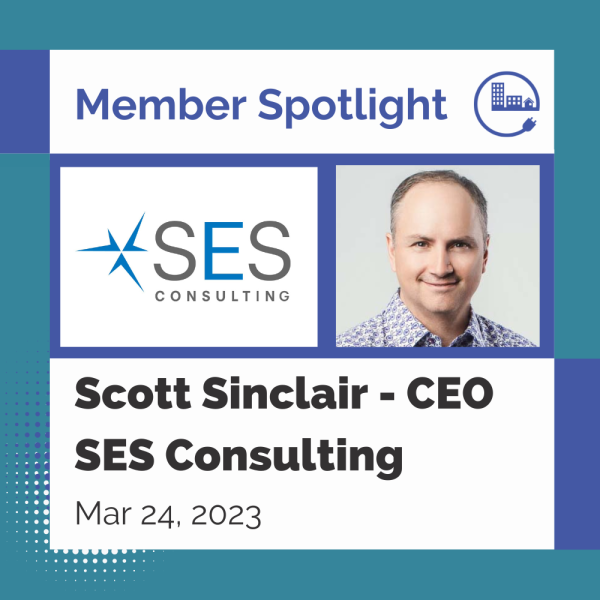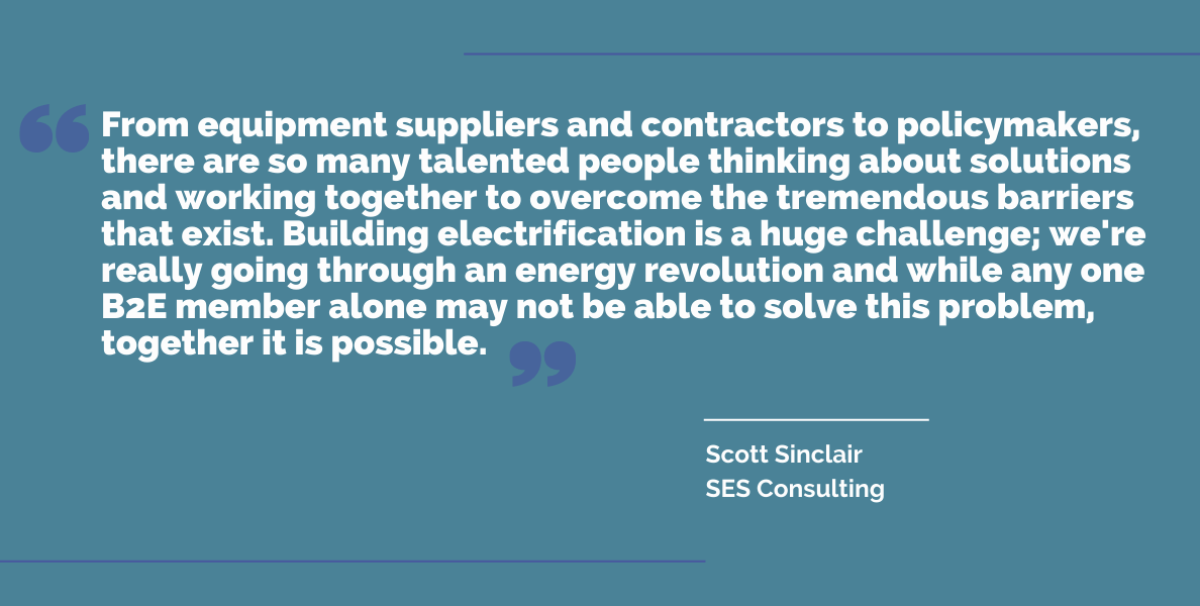
We sat down with building electrification advocate Scott Sinclair, CEO of SES Consulting, a mission-driven engineering firm advancing change through energy efficiency building solutions and retrofits. As a B2E member since October 2021, SES has been an active part of the low carbon building community, exploring not only how we can decrease the carbon footprint of buildings, but how we can make buildings better experiences for the people who use them. Scott serves as a Co-Chair of B2E’s Leadership Council and is a member of the TECH committee, providing strategic insights and actionable solutions for our community.
Why did you become a B2E member?
Before B2E was formed, I was engaged as a stakeholder in the creation of the BERM, the Building Electrification Road Map, and I was also quite engaged with the City of Vancouver to define their carbon pollution regulations. I have strong relationships with different government and municipal stakeholders, like the City of Vancouver, BC Hydro and the Province, so when they approached me about joining, it was a natural fit.
What impact has the B2E community had on you/your organization?
Being part of this community has been useful in better understanding the different challenges that members are having, which informs my decisions as a designer, and to lean on my relationship with this network of experts when I come up against challenges in projects. The B2E member e-mail forum has also been a great, accessible resource about what’s happening in the market around electrification. The overarching benefit of being a part of this community is being a part of something much bigger than myself. I feel confident that the team of people who are at the table, experts in their fields, can move the needle on this.

Tell us about an exciting building electrification project that you’re working on.
I’m currently working on a few exciting projects, the first with the Klahoose First Nation, providing VRF heat pump upgrades to their multi-purpose building. These heat pumps will act as the new primary heating for their community building to offset propane-use in the existing in-floor heating boiler system. The goal of the project is to achieve a 90% reduction in propane, which has major cost saving and resiliency benefits as propane currently arrives by boat to the community. We’re also hoping to train community members on how to maintain this equipment to build capacity.
The second project is with YVR where I’m supporting implementation of the first stage of their reduction target developed through their 2030 Net Zero Carbon Roadmap. Our focus is on utility programs, energy management, measurement and verification planning, in collaboration with other firms as this is a big
undertaking. YVR is looking at heat recovery, energy efficiency, ground source heat pumps, and DHW CO2 heat pumps as their primary technologies to help them achieve their net zero goals.
I'm also working on a phased electrification project at BCIT. In phase one, we electrified the gas-fired infrared heaters in their shop areas with 100% high-intensity electric infrared heaters instead of their long gas-fired tube-style infrared heaters. Electrical service upgrades to the building were required to be able to handle the new load. In phase two, we've been upgrading their office and classroom areas with a new VRF make up air unit and new terminal units that provide variable air volume heating and cooling control into the different spaces. These VRF upgrades enable cooling in spaces that previously did not have it, with highly efficient electrified heating as a co-benefit.
The last project is a hybrid electrification of a 170-unit apartment building for Concert Properties. We've installed a hybrid gas-electric domestic hot water heating system over full-electric due to the limited size of the mechanical room for domestic hot water storage, combined with a lack of electric service capacity. This included an array of Sanden CO2 heat pumps on the roof, paired with backup instantaneous gas boilers to provide reliable domestic hot water whenever it is needed.
What do you see as a key driver in advancing electrification in your industry?
The key driver in advancing electrification in my industry is having a retrofit building code. This will send a clear signal to the market that this is important and required. Right now, all of my projects are voluntary because the building owners I work with are early adopters and thought-leaders. For meaningful market transformation we need market signals that tell us that electrification is coming and that it is necessary.
Do you have any advice for others (individuals or organizations) who want to follow your path?
Be creative and persistent. The design solutions are readily available, and the technology is on the shelf, we just need to put it together and implement it. As a business or organization, find the projects that you can spotlight and use them as beacons to show that we can have success in this space and inspire people to follow suit.
Joining B2E is a great action to take as it’s an excellent way to learn and to meet other companies and individuals who are already embracing electrification and succeeding in project implementation. It comes down to sharing the stories and the learnings that we have with as many people as possible to build momentum so that more and more people can start imagining that electrification is viable.
For more information and to connect with the team, find SES Consulting on LinkedIn.
 b2e@zeic.ca
b2e@zeic.ca


